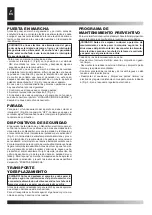
CONTENTS
1. IDENTIFICATION OF PART
1. SAFETY INFORMATION
2. STARTING THE HEATER
2. TURNING OFF THE HEATER
2. SAFETY DEVICES
2. MOVING AND TRANSPORTING THE HEATER
2. PREVENTATIVE MAINTENANCE PROGRAMME
3. HEATER FUNCTIONING DIAGRAM
3. ELECTRIC CONTROL PANEL
4. TROUBLESHOOTING
IDENTIFICATION OF PART
Is a line of hot air generators with indirect heating system.
These generators have a heat exchanger that enables to
separate exhaust combustion gases from the heat released in
the environment, so that it is possible to inject a flow of clean hot
air in the area that needs to be heated and to discharge exhaust
fumes externally.
The hot air generators is designed in compliance with current
safety, performance and life standards, is fitted with safety
devices configured to guarantee continuous operation, minimize
noise and are manufactured in carefully selected materials that
ensure maximum reliability.
SAFETY INFORMATION
WARNING
IMPORTANT: Read the manual carefully before attemp-
ting to assemble,switch on or service this heater. The use
of the heater may cause serious or fatal injuries resulting
from burns, fire, explosion, electrical discharge or carbon
monoxide poisoning.
DANGER:Carbon monoxide poisoning can be fatal!
Carbon monoxide poisoning The first symptoms of carbon
monoxide poisoning are similar to those of flu, with headache,
dizziness and/or nausea.These symptoms may be caused by
the defective functioning of the heater. Go outside into the open
air immediately! Have the heater repaired. Some people feel
the effects of carbon monoxide to a greater extent, especially
pregnant women, those suffering from anaemia, cardiac or lung
conditions, those who are drunk and anyone at a high altitude.
Ensure that you have read and understood all the warnings.
Keep this manual for future reference – it is a guide to the safe
and correct functioning of the heater.
• Use only fuel oil no.1 in order to avoid the risk of fire or explo-
sion. Never use petrol, naphtha, paint solvents, alcohol or other
highly inflammable combustibles.
• Fuelling:
a) The individual responsible for fuelling the heater must have
the relevant competence and be completely familiar with the
manufacturer’s instructions and with current norms concer-
ning the safe fuelling of the heaters.
b) Only use the type of fuel expressly specified on the identifica-
tion label of the heater.
c) Before adding fuel, extinguish all flames, including the pilot
light, and wait until the heater has cooled down.
d) While adding fuel, inspect all the fuel lines and joins to make
sure there are no leaks.
Any leak whatsoever must be repaired before switching on
the heater.
e) In no circumstances must more than one day’s supply of
fuel be stored in the same building in proximity to the heater.
Fuel storage tanks must be kept in a separate location.
f) All fuel tanks must be kept at a minimum distance from hea-
ters, oxyacetylene torches, welding equipment etc. (with the
exception of the fuel tank incorporated into the heater) fol-
lowing regulations.
g) Wherever possible, fuel should be stored in a place where
the floor does not allow fuel to seep through and drip onto live
flames beneath, which might cause fire.
h) Fuel must be stored in compliance with current norms.
• Never use the heater anywhere where petrol, paint solvents or
other highly inflammable vapours are present.
• While using the heater, follow all local ordinances and current
norms.
• Heaters used in the proximity of tarpaulins, curtains or other co-
vering materials must be situated at a safe distance following
regulations. It is also recommended to use fireproof materials.
These materials should be fixed safely so as to ensure that
they do not catch fire and are not blown by the wind.
• Only use in locations where there are no inflammable fumes or
high concentrations of dust.
• Power the heater only with electric power that has the voltage,
frequency and number of phases specified on the identification
label.
• Only use earthed three-wire extension cords.
• In order to avoid the risk of fire, make sure the heater is on a
firm, flat surface when it is being used or is hot.
• When moving or storing the heater, keep it level to avoid fuel
loss.
• Keep children and animals away from the heater.
• Disconnect the heater from the mains supply when not in use.
• When controlled by a thermostat, the heater may come on at
any moment.
• Never use the heater in frequently used rooms or in be-
drooms.
• Never obstruct the air intake (rear end) or the air output (front
end) of the heater.
• When the heater is hot, connected to the mains supply or in
use, it must never be moved, handled, filled up with fuel or
serviced in any way.
1
GB








































